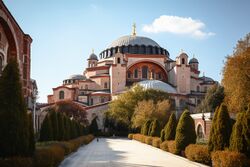Hagia Euergetou
This article is incomplete because it is pending further input from participants, or it is a work-in-progress by one author. Please comment on this article's talk page to share your input, comments and questions. Note: To contribute to this article, you may need to seek help from the author(s) of this page. |
| Hagia Euergetou | |
|---|---|
| Ηαγια Εuεργετοu Basilica of the Holy Benefactor | |
 | |
| Location | Leonople |
| Country | |
| Denomination | Ecumenical Church |
| History | |
| Status | Basilica |
| Founder(s) | Leo IV Iovanius |
| Dedication | Christ the Benefactor |
| Consecrated | 510 |
| Architecture | |
| Functional status | Active |
| Architect(s) | Isidoros of Asti |
| Groundbreaking | 529 |
| Completed | 537 |
| Specifications | |
| Length | 82 m (269 ft) |
| Width | 73 m (240 ft) |
| Height | 55 m (180 ft) |
Hagia Euergetou (Perateian: Ηαγια Εuεργετοu; Anglic: Basilica of the Holy Benefactor) is the premier, imperial basilica in the Perateian Ecumenical Church, and seat of the Ecumenical Patriarch of Leonople.
It was constructed from 489 until 510 under the orders of Leo III Iovianus on the site of a lesser cathedral named Basilica Palatino. It was designed by Isidorus of Asti, and a team of architects from around the ancient Latin Empire. After it's completion, it was dedicated to Christ the Benefactor on Christmas Day 510 and made the seat of the Ecumenical Patriarch, then Archbishop of Leonople. It served as the site of the excommunication of Pope Sixtus XV, a leading cause in Great Schism. Since its construction it has served as the seat of the Ecumenical Patriarch and as the site of all but 3 imperial anointings. Regular church services are hosted at the basilica, and it continues to serve as the the primary venue for anointings, coronations and imperial weddings or baptisms, and other major imperial events. Since 2009, it has been open for limited tours at certain times of the year